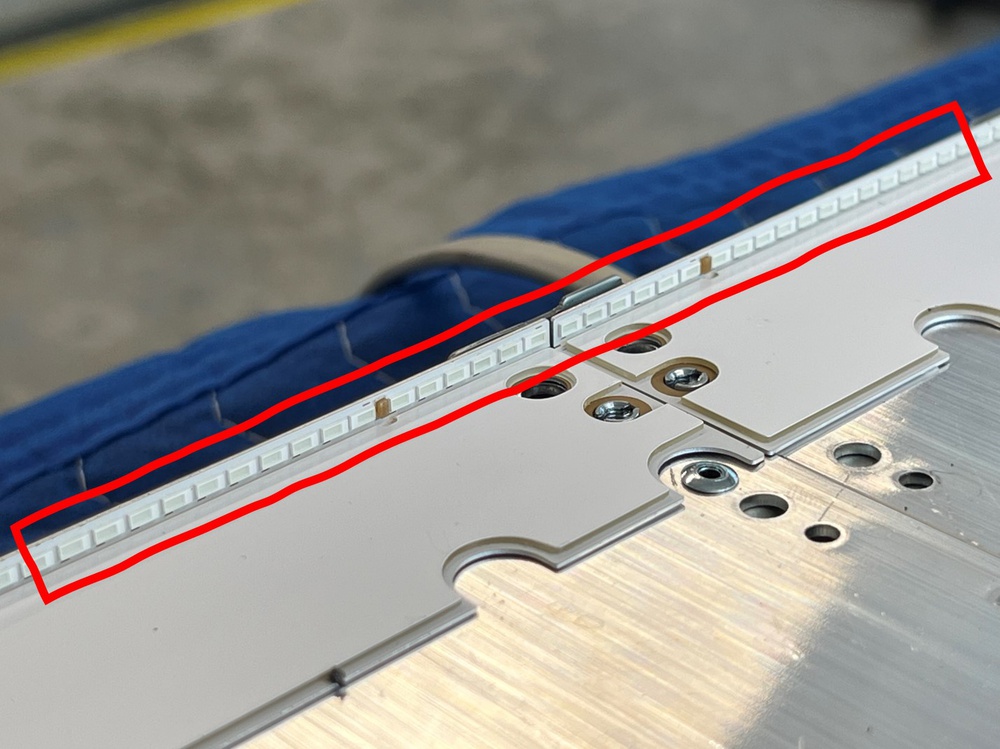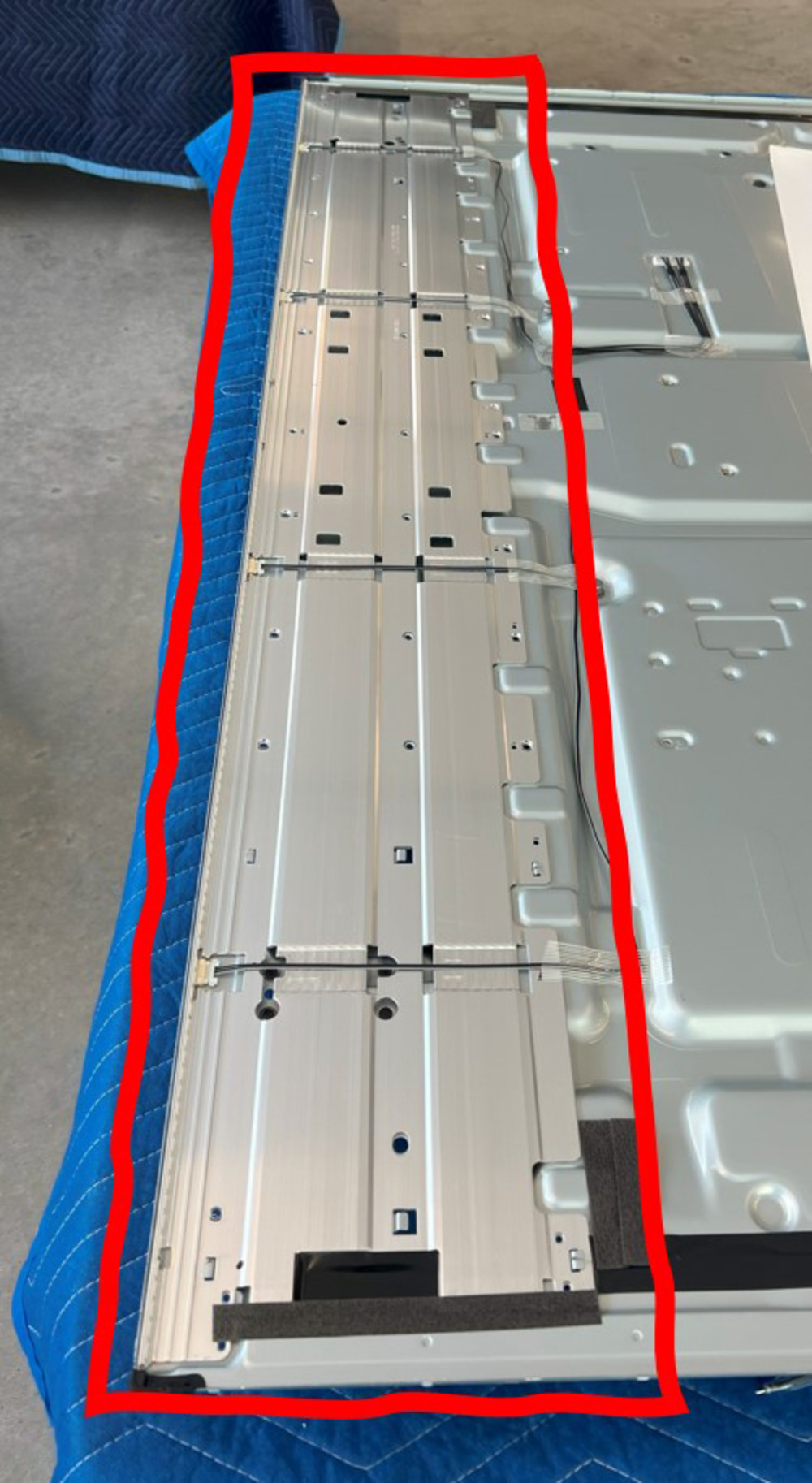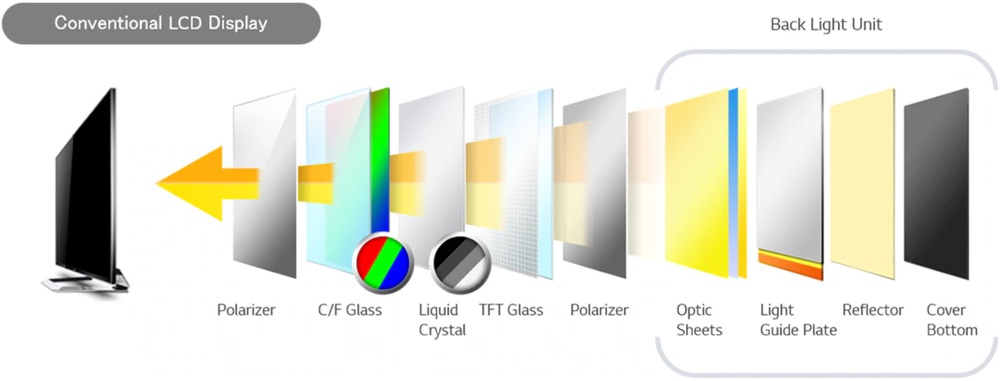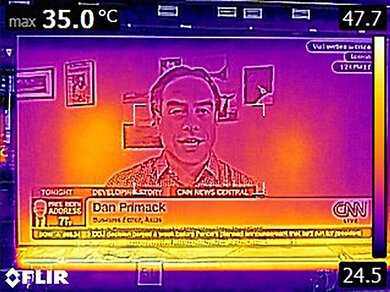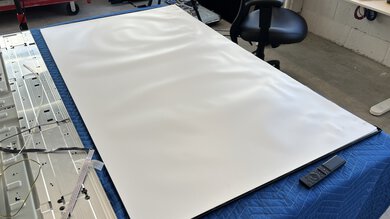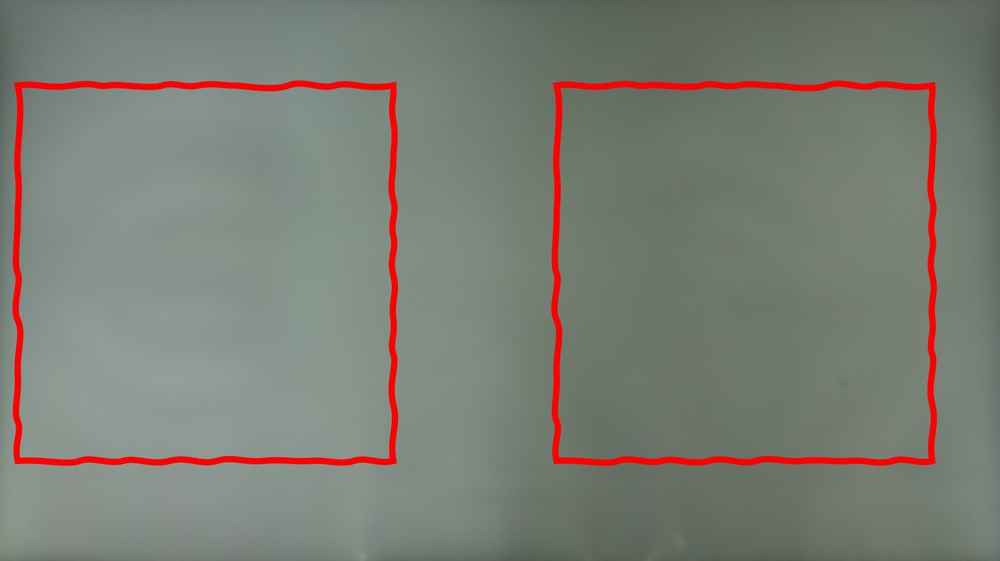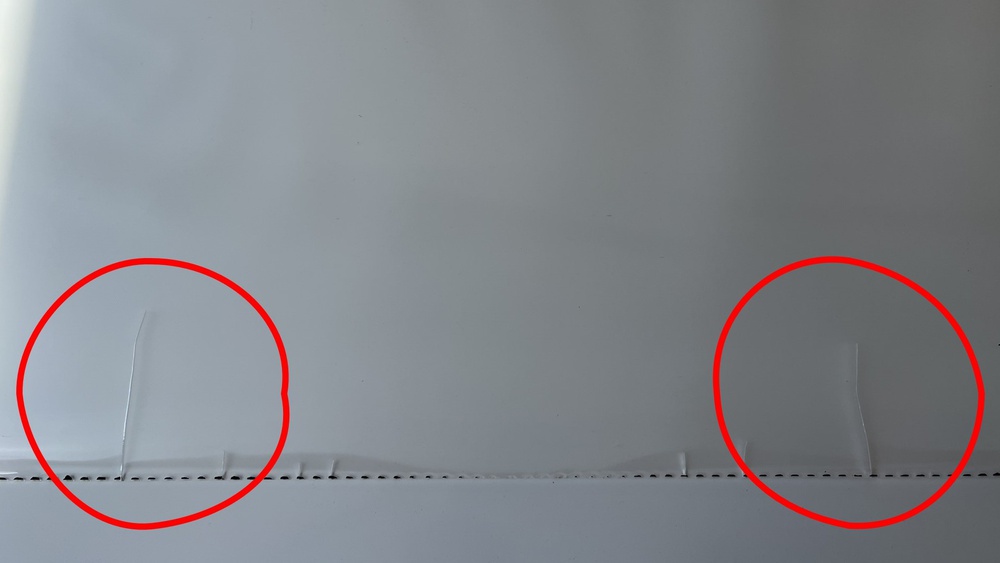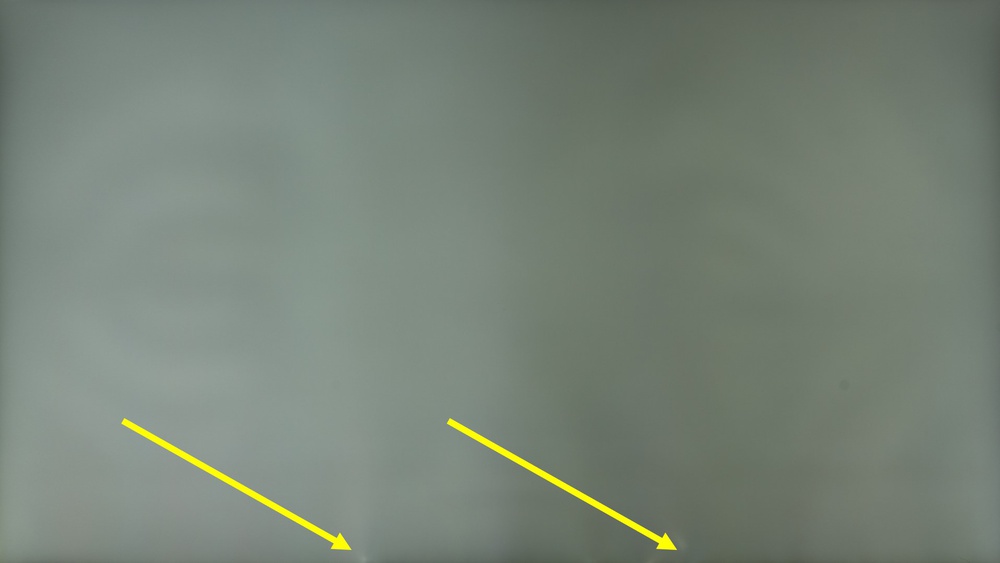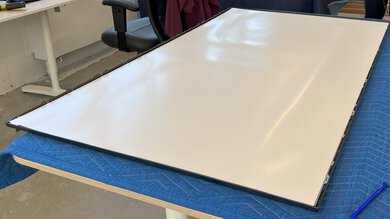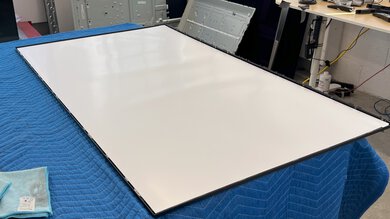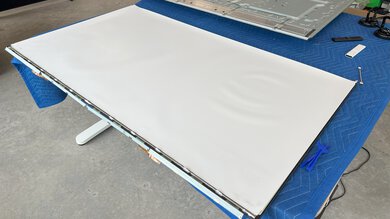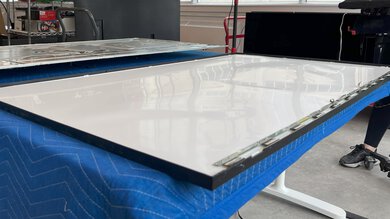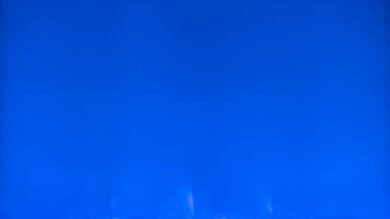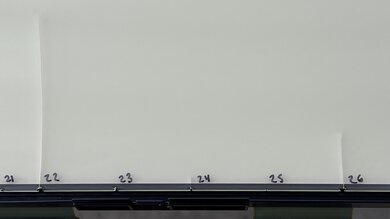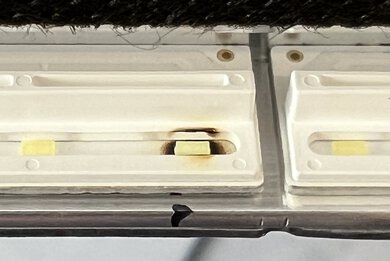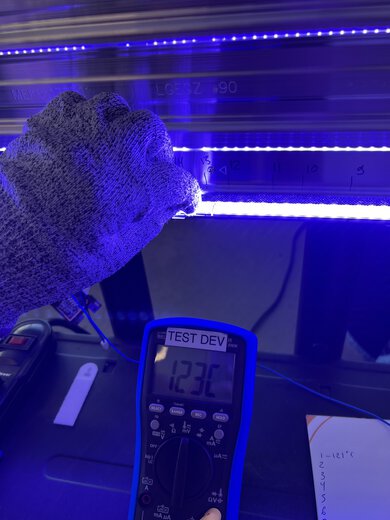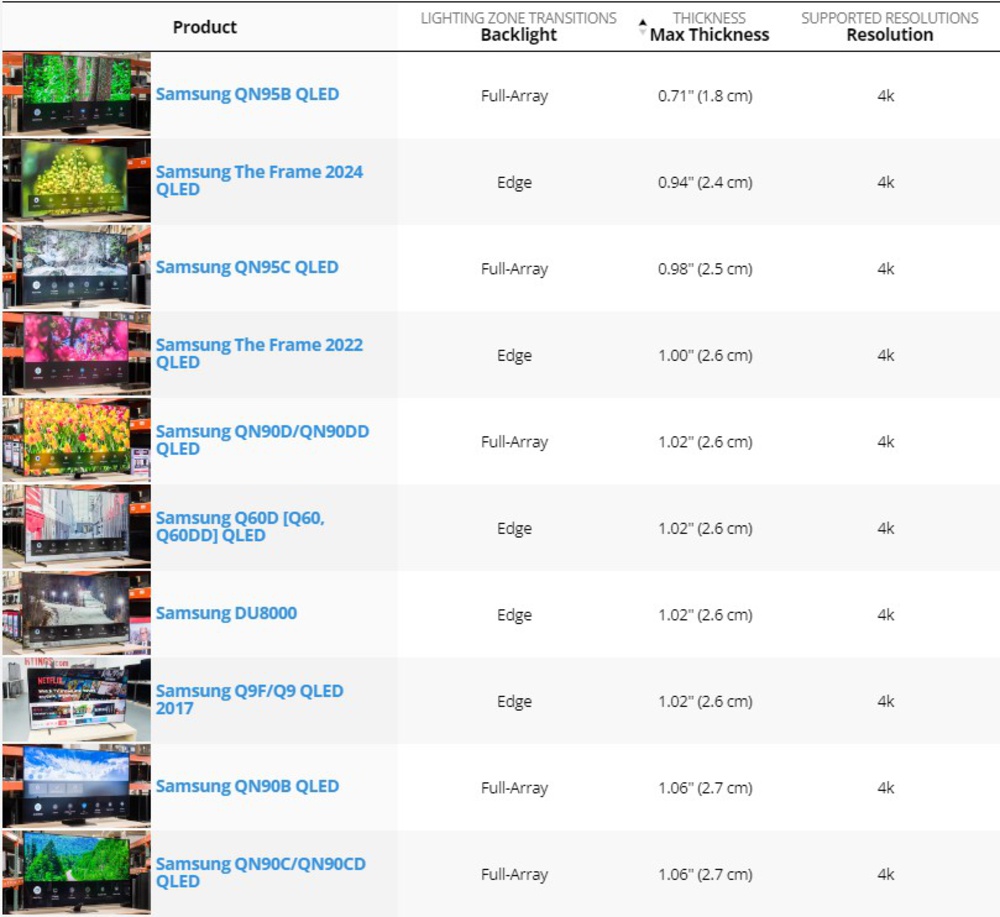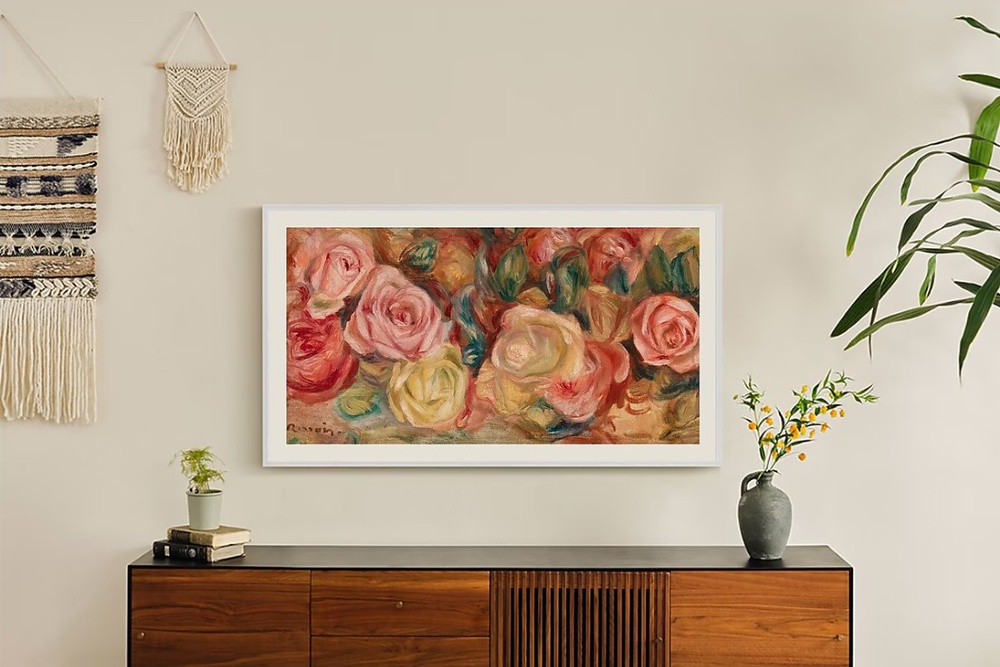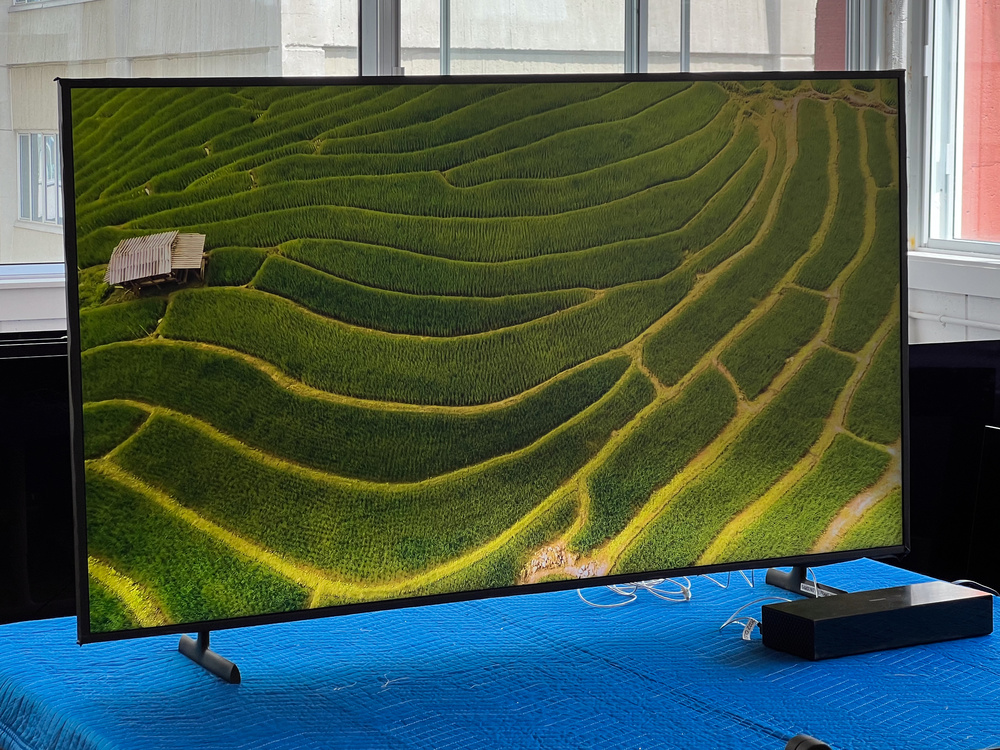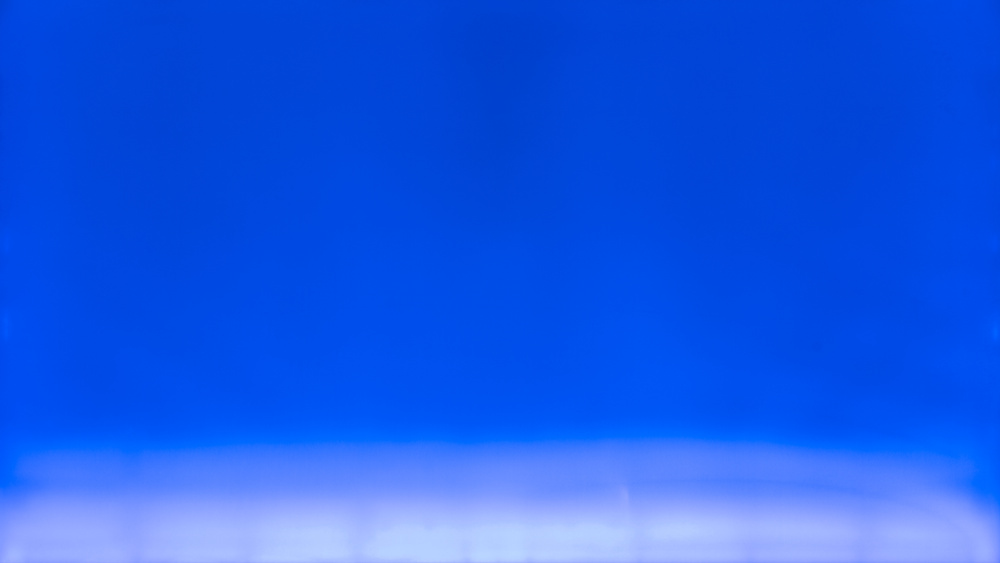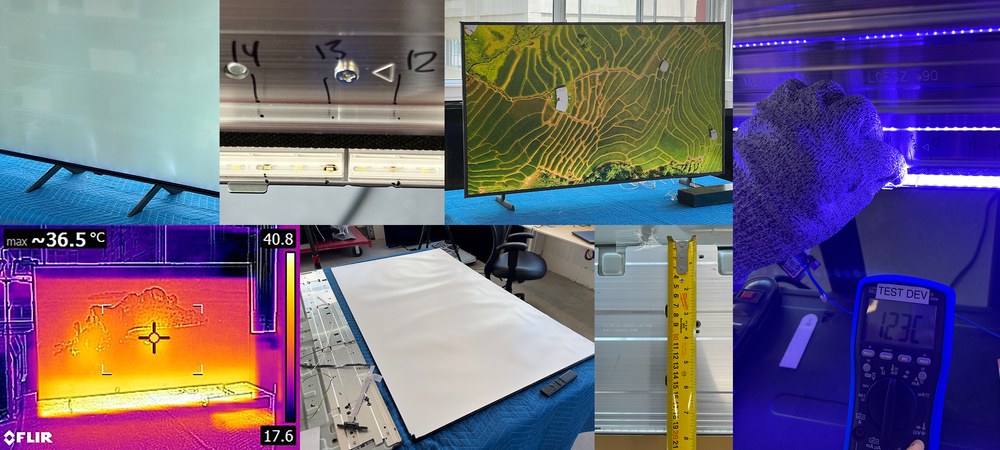 |
Testing products is the core of our work here at RTINGS.com, from consumer electronics all the way to home products like air purifiers and toasters. We strive to make our TV reviews the most comprehensive in the industry, but there's very little information out there for consumers on the long-term durability of TVs. This is why we launched our accelerated longevity test on 100 TVs in October 2022.
At the time of this article's publication, our 100 TVs had been running for over 10,000 hours since the launch of the test, which represents roughly six years of use in a typical U.S. household, based on Nielsen's January 2024 insight report. You can read more information about the test, ongoing results, and failures here.
Summary
The goal of RTINGS.com's ongoing 100 TV longevity test is to push TVs to the limits of their durability to examine failure points as they happen. One clear trend we've observed and investigated is that thin, edge-lit LCD TVs fail prematurely compared to LCD TVs with other backlighting technology.
The results of this investigation are unequivocal: edge-lit TVs are inherently prone to significant durability issues, including warped reflector sheets, cracked light guide plates, and burnt-out LEDs due to concentrated heat. These problems manifest after prolonged use at maximum brightness, posing a significant risk to their long-term reliability.
This analysis, corroborated by real-world observations, highlights a crucial consideration for consumers and the industry. As manufacturers continue to push for thinner designs, addressing these durability concerns is imperative to ensure consumer satisfaction and trust. For consumers in the market for an LCD TV to whom the durability of their purchase is important, we recommend prioritizing models with better heat distribution, such as direct-lit or FALD TVs, for improved longevity and performance.
Uniformity issues appear quickly on edge-lit TVs
Not considering major electronic or electrical failures (e.g., power supply failures, motherboard failures, burnt connectors, etc.), many uniformity issues have popped up on TVs in our test. Excluding the 18 OLEDs, which have burn-in from constantly streaming CNN, over 25% of the 82 LCD TVs in our test suffer from visible uniformity issues.
It gets worse if we look at LCD TVs by their sub-type. Seven out of the eleven (64%) edge-lit models in our test suffer from uniformity issues, one has outright failed, and others are in the process of doing so. In contrast, only 14 out of the 71 (20%) full-array local dimming (FALD) and direct-lit TVs have uniformity issues.
The issues we've encountered with the edge-lit TVs in our test seem to be the same across models and brands. But why is that? By dismantling and investigating our edge-lit TVs with problems, we've seen firsthand that it all boils down to heat and thermal management.
Our sample size is modest in absolute numbers, but it offers good insights into the long-term durability of edge-lit TVs from both Samsung and LG when subjected to our test conditions. So many LG and Samsung edge-lit TVs are in our test because they're the market leaders for these products, with Samsung being the most represented manufacturer with eight edge-lit TVs in our test. For reference, they're run at their maximum brightness setting and subjected to thermal cycling through on/off cycles every day.
It didn't take 10,000 hours for issues to appear on our tested edge-lit TVs. Of the seven with visible uniformity issues, three started showing signs of deterioration at 2,200 hours of testing or sooner, which is around one year of use for a typical U.S. household. The table below summarizes the uniformity issues visible on our edge-lit TVs and the cumulative running time when the problems became visible.
| Brand/Model/Year | LG QNED80 2022 | LG NANO85 2021 | Samsung AU8000 2021 |
| Time to Issue Onset | 7,600 | 3,300 | 2,200 |
|
50% Gray Uniformity @ ~10 000 h |
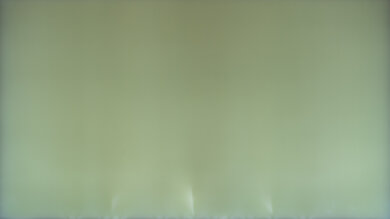 |
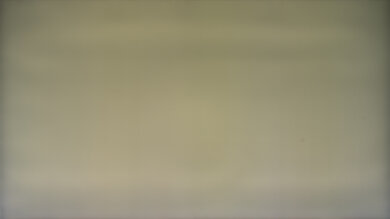 |
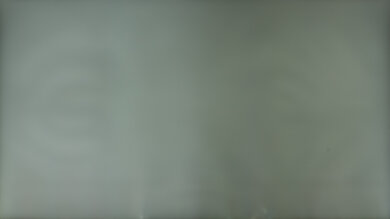 |
| Brand/Model/Year | Samsung Q60A QLED 2021 | Samsung Q70A QLED 2021 | Samsung The Frame 2022 |
| Time to Issue Onset | 2,200 | 2,200 | 3,300 |
|
50% Gray Uniformity @ ~10 000 h |
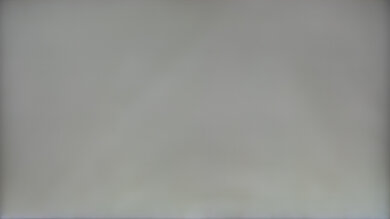 |
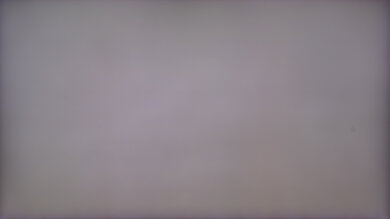 |
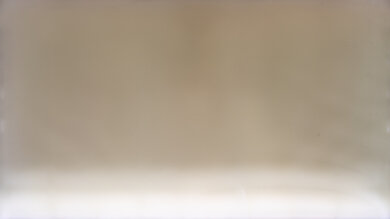 |
| Brand/Model/Year | Samsung Q60B QLED 2022 | ||
| Time to Issue Onset | 5,500 | ||
|
50% Gray Uniformity @ ~10 000 h |
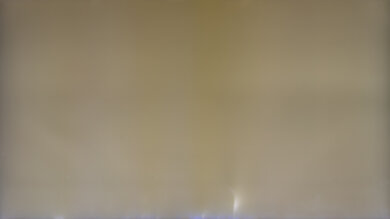 |
||
Except for the Samsung Q70A QLED in the list above, which is holding rather steady, all the other TVs have gotten progressively worse after the issues appeared. Some of these are now showcasing severe uniformity issues, while one of them, the Samsung AU8000, has seen its backlighting completely fail. How they fail is tied to the parts they use and how they generate and distribute their light across the screen.
Where there's light, there's heat: how edge-lit TVs compare to their peers
The basis of how edge-lit TVs light up their screen is simple. As their namesake suggests, they use LED lighting at their lower edge. These strips are attached with an adhesive to a heatsink joined to the rear chassis of the TV. A heatsink is required as there's a high density of LEDs spread over a small area, leading to higher operating temperatures than a FALD or direct-lit LCD TV. For example, a FALD 65" Sony X90L has 160 LEDs spread uniformly over its rear chassis, while a similarly bright edge-lit 65" LG QNED80 2022 has 180 LEDs squeezed tightly together at its bottom edge.
|
LED strip on the edge-lit Samsung Q7F 2017 (55")
|
|
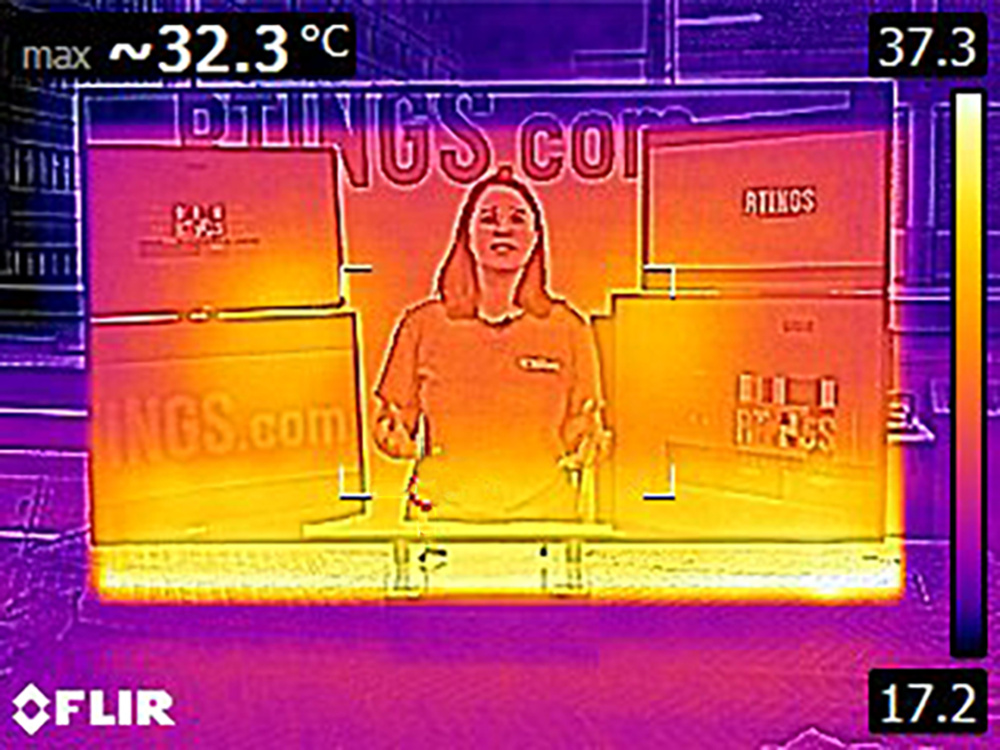 Thermal imaging of the edge-lit Samsung Q70A (55") Thermal imaging of the edge-lit Samsung Q70A (55") |
To spread the light across the entire screen, they use a specialized polymer plate called a light guide plate (LGP) to distribute the light from the bottom of the screen all the way to the top. The LGP is a critical component in edge-lit TVs; without it, light distribution would be so non‑uniform across the screen that these TVs wouldn't be a viable consumer product. Other layers are then stacked on top of the LGP until the light finally reaches the LCD panel (diffuser film, quantum-dot enhancement film (QDEF), brightness enhancement films, etc.).
|
Layers of an edge-lit LCD TV - Source: LG Electronics
|
Below is an example of us progressively adding a reflector sheet and then a light guide plate to the rear chassis of a Samsung Q7F 2017 edge-lit TV. The LGP is what distributes the light over the entire surface of the TV.
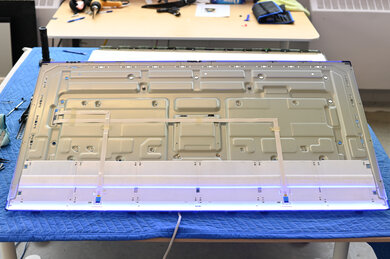 Edge-lit Samsung Q7F: rear chassis with LEDs on Edge-lit Samsung Q7F: rear chassis with LEDs on |
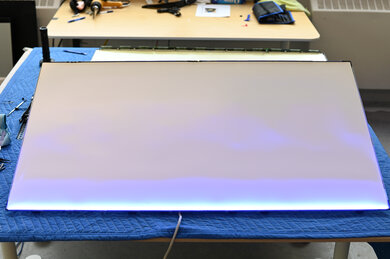 Edge-lit Samsung Q7F: reflector sheet added Edge-lit Samsung Q7F: reflector sheet added |
 Edge-lit Samsung Q7F: light guide plate added Edge-lit Samsung Q7F: light guide plate added |
Full-array local dimming (FALD) or direct-lit LCD TVs don't need to use an LGP as their backlighting isn't limited to the bottom edge of the TV. Rather, it's spread across the entire back chassis of the TV to distribute light behind the LCD panel. They rely on a diffuser plate to make the brightness output uniform.
Below is an example of such a TV, the Sony X90L (65"). The rear chassis is pictured, and the reflector sheet and the 160 individual LEDs for its full-array local dimming backlighting system are visible.
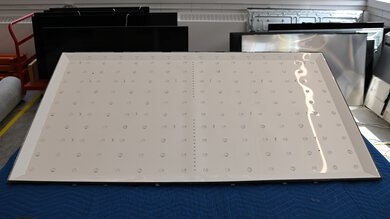 Full array Sony X90L: rear chassis with LEDs off Full array Sony X90L: rear chassis with LEDs off |
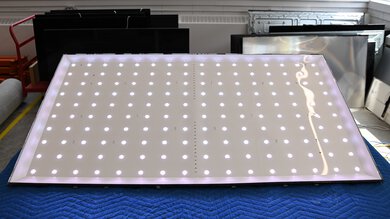 Full array Sony X90L: rear chassis with LEDs on Full array Sony X90L: rear chassis with LEDs on |
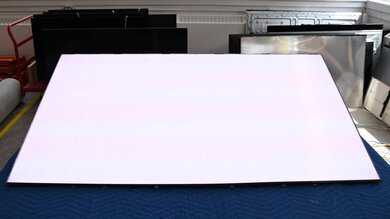 Full array Sony X90L: diffuser added Full array Sony X90L: diffuser added |
Now, on to the hot stuff. Although LEDs are very efficient at converting electricity to visible light, they generate a lot of heat, which TVs must manage while operating. In the case of FALD or direct-lit TVs, this isn't generally an issue, as the heat is distributed evenly across the TV's chassis. For edge-lit models, however, there's a significant concentration of heat at the bottom of the screen due to the location of the LED strips.
The images below show the external temperature measurements of two 55" LCD TVs: one edge-lit and one direct-lit. If you look at the brightness results from our table tool, you'll notice that while they are in the same ballpark, the direct-lit Sony X85J is the brightest. In theory, it should generate more heat during operation than the Samsung Q60T QLED.
 |
Using our thermal imaging camera, we see a significant heat gradient on the edge-lit TV compared to the direct-lit model. It runs significantly hotter at its base, where the LEDs are located, while the direct-lit model has a very uniform heat distribution.
Similar designs & failure mechanisms across brands
After several edge-lit TV models from LG and Samsung, we can confirm that the design of the parts and assembly of edge-lit TVs is quite similar across brands. Unfortunately, so are the failure mechanisms. Let's look at the designs of these TVs from both Samsung and LG and how they compare to those of direct-lit and FALD models.
|
But the issues didn't stop there. We also noticed that cracks had formed in the TV's light guide plate, which also caused visible bright lines to appear at the bottom of the AU8000's panel. Looking closer, we found that the LEDs in the TV had caused the LGP to partially melt around its bottom edge through its entire width. But why is this?
LGPs are offset very slightly from the LED strips in edge-lit TVs, so they avoid touching them using some plastic standoffs. In the case of our AU8000, these standoffs have been melted by the LEDs, which broke them off and caused the LGP to slide downwards by its own weight until it touched the LEDs themselves, which then melted their imprint across the bottom of the LGP and in some cases have partially fused with it. In the picture below, you can see phosphor from the LED fused on the edge of the LGP.
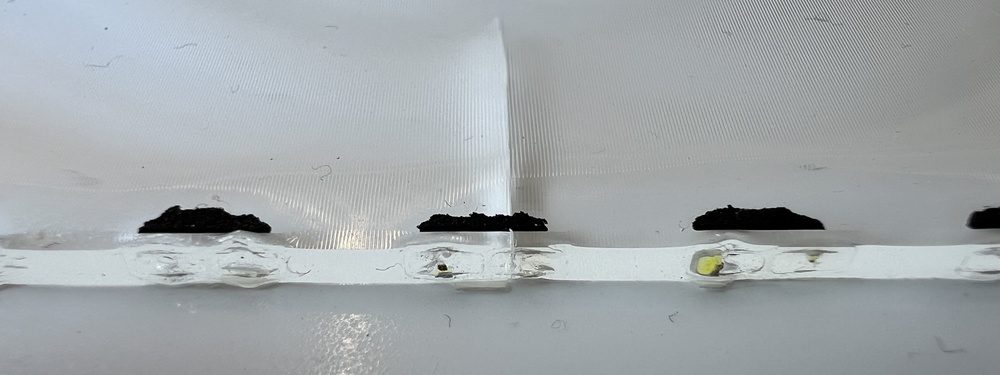 |
Ultimately, the LEDs in the AU8000 stopped working, as many burned out. The LGP and reflector sheet have also suffered considerable damage. If this happens to you, there isn't a strong case to be made for repairing the LEDs, as uniformity issues would persist. If the damage was limited to the LEDs or of an electronic nature, such as a failed power supply or motherboard, it would make sense to replace these components as you could get many more usable hours out of your TV. Changing the LGP and reflector sheet would require harvesting the parts from a donor TV, as you can't readily buy them online.
As mentioned, the AU8000 was our first test subject. Upon opening and investigating the uniformity issues on four other Samsung and two LG models, we quickly realized that the issues are nearly identical across all the edge-lit TVs in our test, regardless of the manufacturer or model, because their fundamental design is identical.
Indeed, we found warped reflector sheets in every single edge-lit TV that we disassembled. They're assembled the same way: the reflector is laid between the LGP and rear chassis of the TV and is held in place mostly by the clamshell design of the TV. There are no areas where reflector sheets are held in place to prevent them from warping aside from a small area around their edges. The warping due to heat exposure is limited to the small area between the LGP and rear chassis since the reflector sheets aren't press-fitted. Below are some examples of what we've seen.
Cracking and melting of the light guide plate is also a commonality. Their bottom edge is positioned extremely close to the TV's LEDs by design to direct the light efficiently. This exposes that same edge to intense thermal stress under load and makes it susceptible to damage in the long run. The pictures below show the visual impacts or large cracks in the LGP on the LG QNED80 2022. This TV had 28 spots where the LGP had started to melt, along with a few large and many small cracks.
|
Finally, a few TVs had issues with their LEDs degrading due to thermal stress, as shown by burnt-out LEDs in the AU8000 and scorch marks around LEDs in the LG QNED80 2022. At the time of writing this article, the LEDs with burn marks around them in the LG QNED80 2022 were still functioning, but we will be keeping a close eye on them as we expect they will eventually fail from the thermal damage. While our FLIR thermal camera gave us a good idea that LEDs in these TVs got hot during use, we decided to take it a step further and use our thermocouple to see just how hot edge-lit TV LEDs get during use. In the LG QNED80 2022, the surface temperature of the LEDs can reach 123°C (253°F) during use at the TV's maximum brightness setting. This heat generation multiplied by the number of LEDs in edge-lit TVs amounts to a very high heat density over a small surface area, which is why heat sinks are so important in the design of these TVs. Unfortunately, they don't do much to prevent the LGP from being exposed to the heat radiating from the LEDs' surface or the flux they generate. The evidence from our testing and investigation into the edge-lit TVs with issues shows that the heat generation from the LEDs is bound to impact every edge-lit TV sooner or later if it's used at its maximum brightness level. Expensive edge-lit TVs aren't immune to these effects either, as they share the same basic design as more affordable models. |
Why are edge-lit TVs still around?
Over the years, our testing results have shown that edge-lit LCD TVs typically have lower picture quality when compared to their FALD peers. The highest-scoring edge-lit TV we've tested, the Samsung The Frame 2022, scored 7.9 in our Mixed Use TV usage. This leaves it in 30th place out of all the LCDs we've tested after sorting them in our TV Table Tool. All models ahead of the Frame 2022 are FALD, and many are available at lower prices. From a performance standpoint alone, one could wonder why edge-lit TVs are still around. Perhaps because they are cheap to manufacture?
Interestingly, the reason they're still on the market isn't because they're cheaper to manufacture than other types of LCD TVs. Edge-lit TVs are generally more expensive than comparable direct-lit or FALD TVs to manufacture due to specialized hardware requirements such as their light guide plate or LED heatsink, as well as tighter manufacturing tolerances to ensure proper alignment of the LEDs with the LGP, as a minor misalignment of these components can cause significant light distribution issues. We don't think edge-lit TVs fail because they are cheap but rather because of inherent design flaws of the technology itself.
Considering they have limitations in terms of performance and aren't cheap to manufacture, why are edge-lit TVs still around?
|
Thin TVs sell—and they sell quite well. |
Edge-lighting allows manufacturers to cost-effectively offer some of the thinnest LCD TVs on the market. Below is a table showcasing the average thickness of all LCD TVs we've tested from 2017 to 2024. This reveals that edge-lit TVs are, on average, the thinnest LCD TVs on the market, though some very high-end FALD LCD TVs are thinner than the thinnest edge-lit models we've tested.
| Backlighting Technology | Edge-Lit | Full-Array Local Dimming | Direct Lit |
| TVs tested by RTINGS.com (2017 - 2024) | 70 | 116 | 80 |
| Average TV thickness | 56 mm (2.20") | 62.4 mm (2.44") | 77 mm (3.03") |
Some manufacturers do a fantastic job giving their edge-lit TVs the thinnest profile possible, notably Samsung, which dominates the top spots for the thinnest TVs we've ever tested for both its LCD and OLED models. In fact, five edge-lit TVs from Samsung are in our top 10 of the thinnest 4K LCD TVs we've ever tested.
Samsung's The Frame series have been some of the most popular and acclaimed edge-lit TVs on the market ever since their inception. These lifestyle TVs offer an unparalleled mix of style and function as they turn into literal pieces of digital art when they're turned off. Being edge-lit allows both The Frame 2022 and The Frame 2024 to be the thinnest 4K LCD TVs we've tested after the considerably more expensive and premium QN95-series from Samsung.
|
Samsung The Frame 2024 (Source: Samsung)
|
Samsung The Frame 2024 (Source: Samsung)
|
However, as a result of our investigation and our own experience with the Samsung The Frame 2022, we expect that these thin lifestyle TVs will be subjected to fail prematurely due to the heat generated by their edge-lit design if you use them for extended periods at high brightness levels.
Indeed, our $1,999.99 USD MSRP 65" model suffered from a warped light guide plate due to heat from both the LEDs and their heatsink at the lower end of the TV, which caused severe uniformity issues. The lower section of the screen became over-brightened by light escaping between the LGP and other optical layers between it and the LCD panel.
|
Samsung The Frame 2022 showcasing light bleed due to a warped LGP
|
Hisense's upcoming lifestyle TV, the Canvas, will be a direct competitor to Samsung's Frame series. Unsurprisingly, the Canvas will also use an edge-lit backlighting system to ensure the TV has the thinnest profile possible.
Beyond our longevity test: how do edge-lit TVs perform in the wild?
During a recent trip that our display R&D team took to SID Display Week 2024, we were already in the process of planning this article. Serendipitously, we also encountered a lot of edge-lit TVs both at the San Jose Convention Center and in restaurants that were suffering from what appeared to be the same issues as the models in our test.
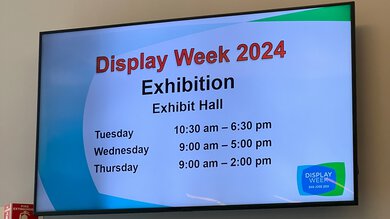 |
 |
 |
Once you start noticing these issues, you'll soon find yourself noticing them everywhere. However, we need to be very clear about something: we expect that the TVs shown in this section have run for many thousands of hours at their maximum brightness level based on their use in commercial settings.
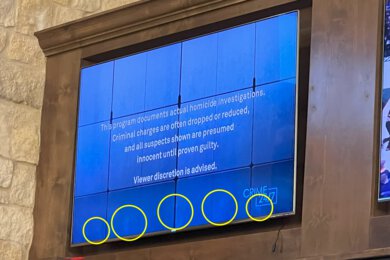 |
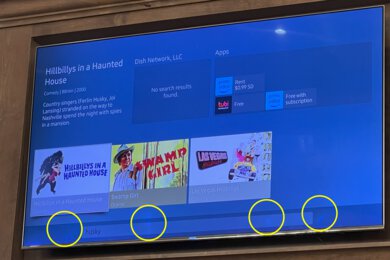 |
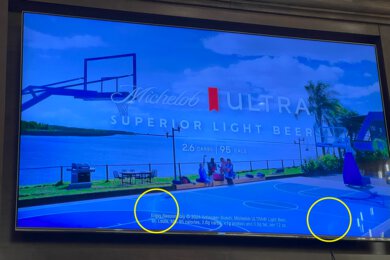 |
If you noticed an odd blue tint on the three TVs shot in a restaurant, you're onto something. Generally, this is due to the encapsulation of the backlight LEDs degrading and allowing flux from the blue LEDs to bypass the Ce:YAG (Cerium-doped Yttrium Aluminum Garnet) phosphor responsible for generating white light. This issue isn't limited to edge-lit TVs and can affect any LCD TVs that use white LEDs as their backlight. It's a topic we're hoping to investigate further down the line.
How it impacts you as a consumer, and what you can do about it
What does our investigation mean to you? There's no simple answer to this question. It isn't as cut and dry as it would seem. Instead, consider our results on a case-by-case basis.
If you currently own an edge-lit TV and keeping it for more than 5 to 7 years is important to you, we'd suggest avoiding prolonged use of the TV while it's at its maximum brightness setting, as this will reduce the thermal stress generated by the backlighting system and may help preserve the integrity of your TV's LGP and reflector for a longer period. However, this may not prevent heat from both the power supply and motherboard from warping the reflector sheet in your TV over time (thankfully, it's usually less visible in real content than damage to the TV's LGP).
If you're in the market for an LCD TV and your primary concern is durability, it may be wise to look at a direct-lit or FALD model rather than an edge-lit one. Although no TV is immune to uniformity issues, you'll at least steer clear of issues related to LGP damage, as this part isn't used in non-edge-lit TVs. Furthermore, the reflector in these other LCD TVs is generally secured in multiple locations, and our testing thus far indicates that it is likely immune to the issues we've observed in edge-lit models. If you want a thin, edge-lit TV for aesthetic reasons, you may benefit from purchasing a bright, higher-tier model that gets brighter than what you need and then use it at a lower brightness level to increase its useful life.
Note that as we didn't assess the reliability or investigate how edge-lit monitors are built, it would be unwise to apply our TV conclusions to them. Edge-lit monitors are still widely commercialized; typically, they get as bright as edge-lit TVs. We think there's likely less room for heat-related issues as LEDs don't need to be driven as hard to light up their considerably smaller screen surface area. If you've experienced problems with an edge-lit monitor resembling those seen in TVs, we'd love to hear about it in the comments.
It's important to keep in mind that these products are designed to sell at a specific price point and offer select features to consumers (e.g., a thin profile, etc.) and that it would be unrealistic to expect manufacturers to "overbuild" them to make them last 20 years as manufacturing cost increases would likely make these products commercially unviable.
Statements from TV manufacturers
Before publishing this article, we reached out to TV manufacturers for comments on our findings regarding the durability of edge-lit LCD TVs. The contacted manufacturers were LG and Samsung, as their models were the subjects of our investigation, and Sony and Hisense. We contacted Sony to see whether they had insights on the durability of edge-lit models even though they no longer have them in production. We contacted Hisense due to the upcoming launch of their Canvas lifestyle TV, which will feature edge lighting.
As detailed below, we received responses from LG Electronics, Samsung Electronics, and Hisense at the time of publication. We'll continue to update our article with any relevant information.
Samsung Electronics statement:
"Edge-lit technology has been reliably used in our LCD products for over 15 years, showing durability comparable to direct-lit models in real-world conditions. We have continuously improved the optical components and thermal management of edge-lit models, subjecting them to over 20 long-term reliability tests, including high-temperature testing. We remain dedicated to ongoing technological development to further enhance product quality."
LG Electronics statement:
"While we may see differences in the [types of failures] between [edge-lit and full-array or direct lit LCD TVs], we have not seen any difference in the defect rate. There [are] no special [measurements] or processes that we have taken to address specific durability issues only for [edge-lit TVs]. That said we do engineer to a common standard and focus on reliability through all of the developmental stages. In general, the stress points of [LCD TVs] are related to heat and light. Because of this, the first thing we do is to check the durability of the material components that we use and do an accelerated stress test of [them] under various light and heat conditions. We then adapt the optimal thermal/optical diffusion structure to compensate for external environmental factors and use conditions. We then develop LCM (Light Control Modules) that take into account any expansion and contraction of parts. Developing the LCM this way allows us to also conduct multiple accelerated reliability tests and long-term usage tests. The finished product is also built and verified in the same way. For your reference, our edge-lit LCD TVs have an aluminum heat dissipation structure to address any heating problems from the light source, and the durability of heat dissipation of finished products is tested. In order to improve the reliability of TVs, we are conducting continuous research and development by subdividing the development organizations into 3 organizations:
- Pre-development [organization, which] researches new materials and structures with improved durability according to our internal road map, taking into account customer feedback and then research materials and structures related to that feedback.
- Dedicated model development, which quickly adapts planning from internal and external sources and continuously develops future models which may include working with external partners.
- Our development reliability organization which monitors and improves customer issues and researches consumer feedback and pain points.
With these efforts, we are launching more improved products in terms of performance and reliability as the year continues every year.
We always recommend to our customers that they read the manuals associated [with] their models for proper care and usage. By doing so, the customer can enjoy many years of enjoyment from their [LG TV]."
Hisense statement:
"For your information, none of the models we launched this year are Edge LED so far. Nonetheless, we support your research and look forward to seeing the results, including the various pros and cons of using edge-lit LCD TVs."
